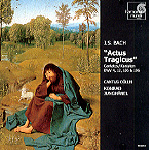In presenting four of Bach’s early cantatas–three of which were composed in the “pre-Weimar” years when Bach was in his early 20s–this disc makes it easy to appreciate the full-fledged maturity and awesome creative fertility that seems to have lived inside this greatest of all composers from the day he first put pen to paper. All four cantatas work well–and indeed, as with BWV 106, may all have been conceived this way by Bach–when performed by four solo voices as they are here. Three of the cantatas use scoring typical of Bach’s early works in the genre, employing two violas da gamba, lending the sound a reedy resonance. The opening “Sonatina” of the funeral cantata BWV 106 (“Actus tragicus”), with its vibrant gambas and mellow, sighing recorder melody, reaches into the depths of the soul, offering warmth and comfort–a perfect preparation for the opening words, “God’s time is the very best time.” And what better depiction of mood and actual word meaning than Bach’s opening chorus of BWV 12–“Weinen, Klagen, Sorgen, Zagen” (“Weeping, lamenting, worrying, fearing”), with its penetrating succession of suspensions, dissonances, and resolutions? The Actus tragicus sometimes sounds like a kind of experiment–Bach tosses in several surprising and unusual twists of form and thematic treatment–while the Easter cantata BWV 4 represents the composer at his most polished and profound while still managing to show off an impressive creative range.
The singers demonstrate virtuosic technique and versatility throughout, and are not afraid to infuse their singing with real emotional depth. In the final chorus of BWV 196 they show what tremendous excitement can be achieved from just four voices and a few exceptional instrumentalists who happen to have some pretty good music to perform. There are of course pros and cons to performing this music with four distinctly individual solo voices, and aside from the benefits noted above, there are times that the exuberance of one voice suddenly disrupts the ensemble balance, or where you might wish for the more substantial weight and finely tuned blend of a chorus. And if you don’t happen to like one of the soloist’s voices (I’m not fond of soprano Johanna Koslowsky’s frequently used, overly straight-toned affects), you’re stuck with it even in the ensemble sections. These personal preferences aside, you can be assured that what you’ll get here are solid, informed, and musically engaging performances that will serve your library well. The “up-front” sonics certainly grab you, but I would have preferred to sit a few more rows back.
































